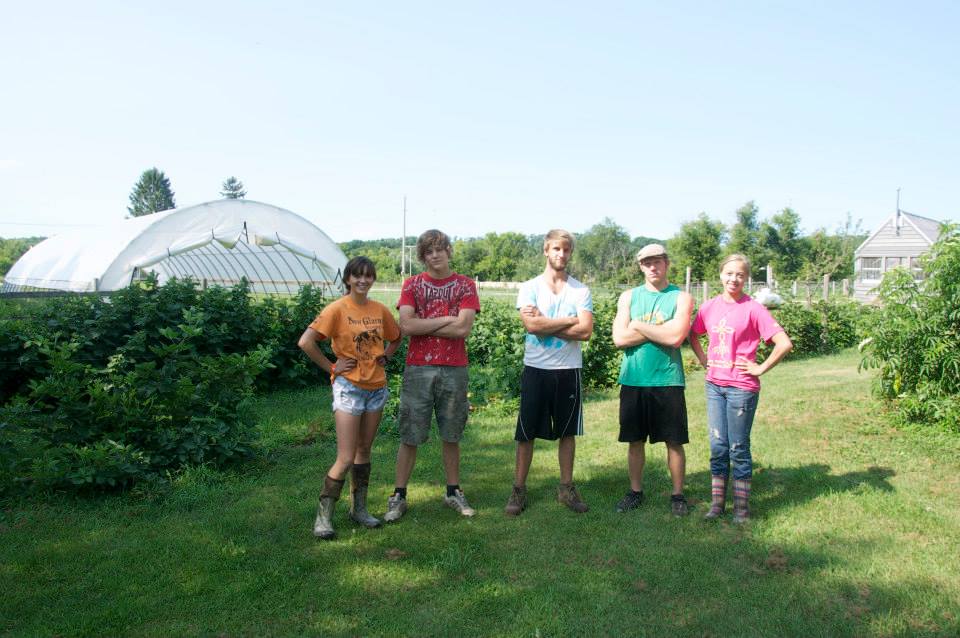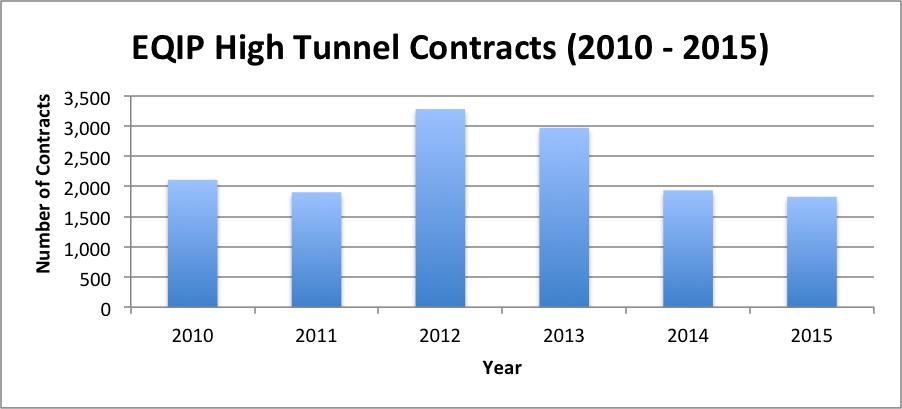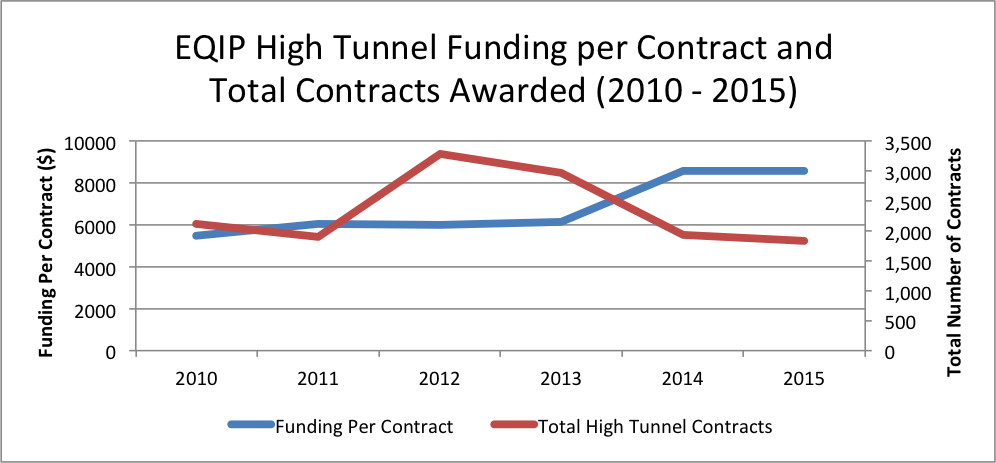
Zoë Bradbury of Valley Flora Farm is part of a team of family farmers (Zoe, her sister Abby, and her mother Betsy) raising over 100 varieties of organic fruits and vegetables on 90 acres along Flora’s Creek in Langlois, Oregon. Their CSA serves families within a 50-mile radius and the farm is committed to sustainable practices. Farming along Oregon’s famously wet, blustery coast means Valley Flora’s crops need to be able to withstand cool summer temperatures, high winds, and rainy shoulder seasons.
To manage these challenges, Bradbury applied for the Natural Resources Conservation Service’s (NRCS) Environmental Quality Incentives Program (EQIP) Seasonal High Tunnel Initiative, which offers cost-share funding and technical assistance to farmers who want to extend the growing season on their farms by using high tunnels. High tunnels (or “hoop houses”) are hoop-like structures covered with plastic and placed over growing areas to help control the growing environment inside. High tunnels require no energy use, and rely only on natural sunlight to heat the tunnel, creating conditions that are favorable for warm-season vegetables and other specialty crops.
Through the EQIP initiative, Zoë and her family were able to build two high tunnels on their farm in 2014, which have been a big help in extending their growing season and mitigating the coast’s weather variability. The high tunnels on Valley Flora Farm work in tandem with the Bradbury’s other conservation practices, including cover cropping and using drip irrigation to manage water efficiently and minimize weed pressure.
“On the coast, our crops really need an extra heat boost through the summer,” said Zoë. “For example, with the high tunnels, we are able to start harvesting sweet peppers in July rather than in September. It’s a dramatic leg up for us in terms of season extension and our customers want to buy them for as long as we can have them.”
Program History
The EQIP Seasonal High Tunnel Initiative first began in 2009 as a three-year pilot program to help NRCS assess the potential environmental benefits resulting from the use of high tunnels. After experiencing consistent growth in participation over the first three years, the seasonal high tunnel initiative became a conservation practice standard (Conservation Practice #325) in fiscal year (FY) 2014, making it available in all states.
The pilot program initially set a maximum size of 2,178 square feet (5 percent of an acre) of high tunnel that could be funded through NRCS. Today, however, states are no longer permitted to limit the size of the hoop house size, but they can opt to establish a cap for the level of funding that participants can receive for the practice.
Beginning in FY 2016, NRCS allowed states to decide whether to offer high tunnels as a state initiative or simply a conservation practice available as part of general EQIP. While all states are required to offer the practice, NRCS aimed to keep the initiative as an option for states aiming to promote the practice and increase high tunnel participation in their state.
Between 2010 and 2015, the EQIP Seasonal High Tunnel Initiative has provided assistance for over 14,000 high tunnels in all fifty states, obligating over $93 million during that period.
2015 High Tunnel Contracts
In FY 2015, NRCS awarded 1,830 high tunnel contracts, which is relatively consistent with 2014 numbers, but a significant decline from 2012 and 2013.
As was the case last year, we suspect that the removal of a cap on the maximum high tunnel size in FY 2014 likely contributed to larger contracts and therefore an overall decline in the number of high tunnels that NRCS was able to fund.
As the chart below indicates, the total number of contracts decreased in FY 2014 and 2015, but the funding per contract rate was higher for those two years than previous years.
In addition to the elimination of an acreage cap, the structure of how high tunnel funds are allocated also shifted in 2014. States were originally given a specific allocation for the initiative that could be rolled over if funds were not used.
The funding for the Seasonal High Tunnel Initiative now comes out of the states’ general funds, but prior to 2014, there was a specific allocation for the initiative in each state, and funds could be rolled over if not used in a given fiscal year.
While funding for high tunnels is still available through a general fund, states now have the option to operate the program as a separate initiative, or a conservation practice available through general EQIP.
Contracts Continue to Serve the Historically Underserved
The percentage of high tunnel contracts going to beginning, socially disadvantaged, or limited resource producers (referred to collectively as “historically underserved producers”) continued to rise in FY 2015. 86 percent of 2015 EQIP High Tunnel contracts went to historically underserved producers; up by 7 percent from last year.
Beginning farmers made up the largest portion of all EQIP high tunnel contracts in FY 2015 (62 percent). This is significantly higher than the percentage of general EQIP contracts awarded to beginning farmers, which was 24 percent in FY 2015.
EQIP high tunnel payments are made based on a set rate-per-foot of high tunnel constructed. Historically underserved producers are eligible for higher payment rates within all statewide and county level programs under EQIP – up to 90 percent of total costs.
These farmers are also eligible for up to 50 percent advance payment for costs associated with planning, design, materials, equipment, installation, labor and management. This provides much needed support – particularly for beginning farmers as they tackle the challenges of getting started in farming.
In addition to the higher payment rate and advance payment, five percent of all EQIP funding is set aside for beginning farmers and ranchers, and an additional five percent is set aside for socially disadvantaged producers.
Seasonal High Tunnels and Conservation Benefits
High tunnels were first established as an interim conservation practice to assess the environmental benefits of high tunnels used in tandem with other conservation practices.
Today, farmers are overwhelmingly finding success with the initiative. According to data collected by NRCS, many of the farmers holding EQIP high tunnel contracts are also implementing other critical conservation practices through EQIP, such as runoff mitigation, pesticide reduction practices, and soil biodiversity enhancement.
One example from NRCS’s FY 2015 data shows that 12 percent of EQIP high tunnel contract owners also held contracts in nutrient management. Nutrient management helps provide a roadmap to help producers apply nutrient sources in the right amounts at the right times to optimize agricultural and environmental benefits.
Additionally, 11 percent of FY 2015 high tunnel contract owners also used cover crops, 5 percent used conservation crop rotation, and 2 percent used integrated pest management systems.
Season Extension and Crop Rotations
To farmer Kriss Marion of Circle M Farm in Blanchardville, Wisconsin, hoop houses are not just a valuable resource for her farm production but also a sign of the spread of sustainable, diversified farming throughout her region.
“It feels like a way to measure the success of sustainable agriculture in our county – they are a visible sign of progress,” said Kriss. “I get more phone calls, too – people see the hoop and say, ‘Oh, there’s a vegetable grower.’ ”
Kriss’ hoop house is even in demand as a backdrop for photo and video shoots done in the area.
On a small, diversified operation such as hers – which is focused on selling directly to local customers at farmers’ markets and through a CSA – the versatility of the hoop house is a big asset.
Kriss’ favorite crop to grow inside the hoops thus far has been a combination of cucumbers and salad greens.
“[Cucumbers] grow great in there – they’re tender at the start of the season and can get frost nipped in the fall, but they just grow and grow and grow in the hoop,” said Kriss. “I tried greens interseeded in the partial shade of the cucumber vines, which lengthened our greens season by protecting them from peak summer sunshine.”
Circle M’s hoop house is part of their crop rotation system, which means that Kriss grows something different in the hoop house each season on a 4-year cycle. This year, the hoop contains sweet potatoes. Wisconsin is farther north than the tubers’ ideal growing range, but inside the hoop, Kriss reports success:
“I always have a bigger, better crop when they’re in the hoop in our rotation.”





